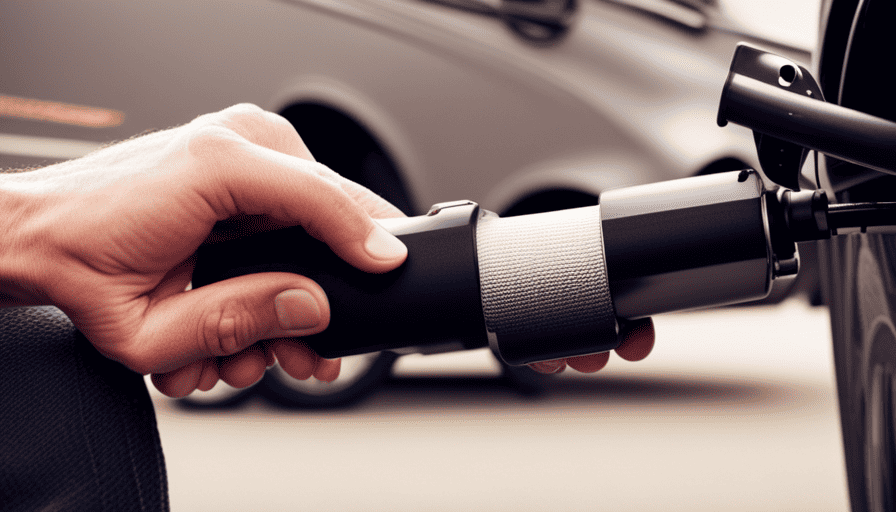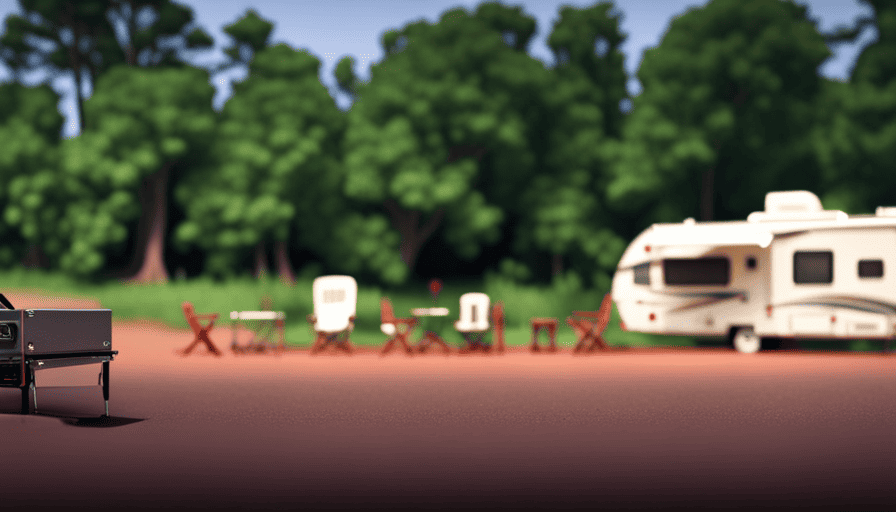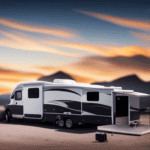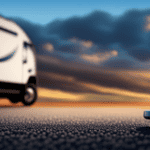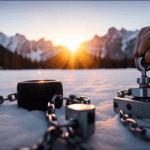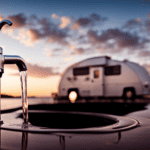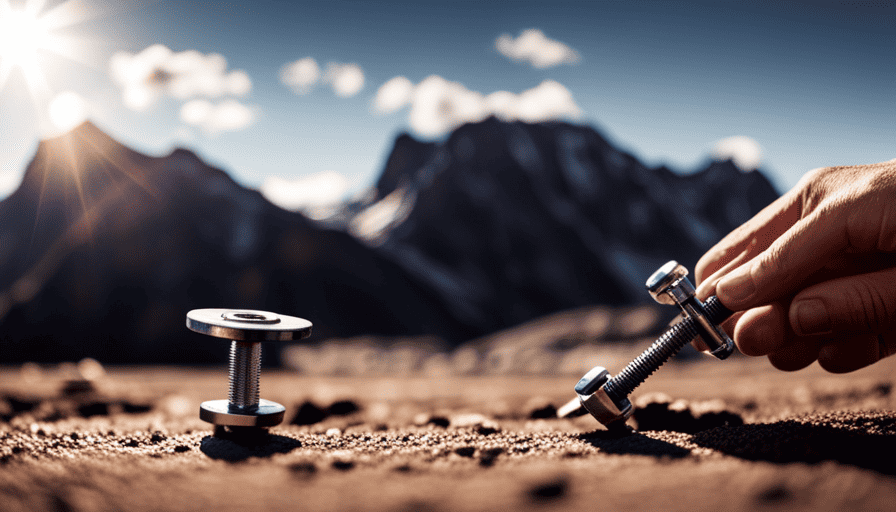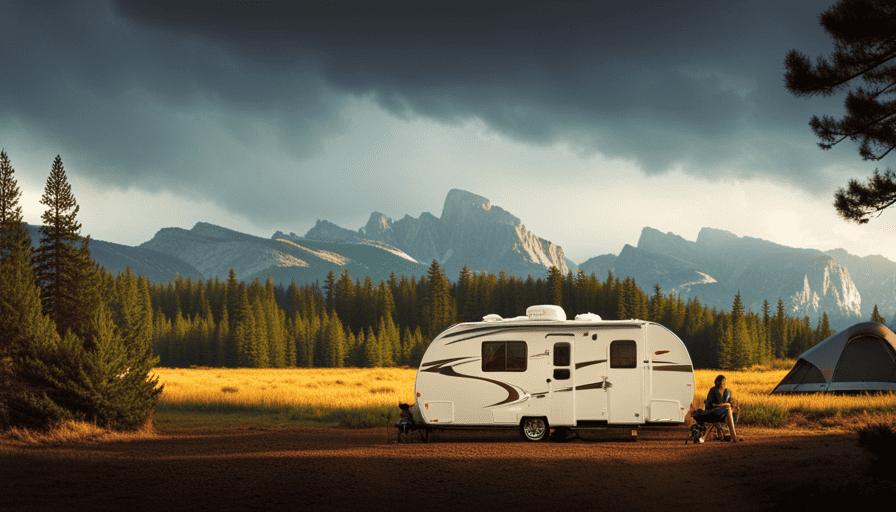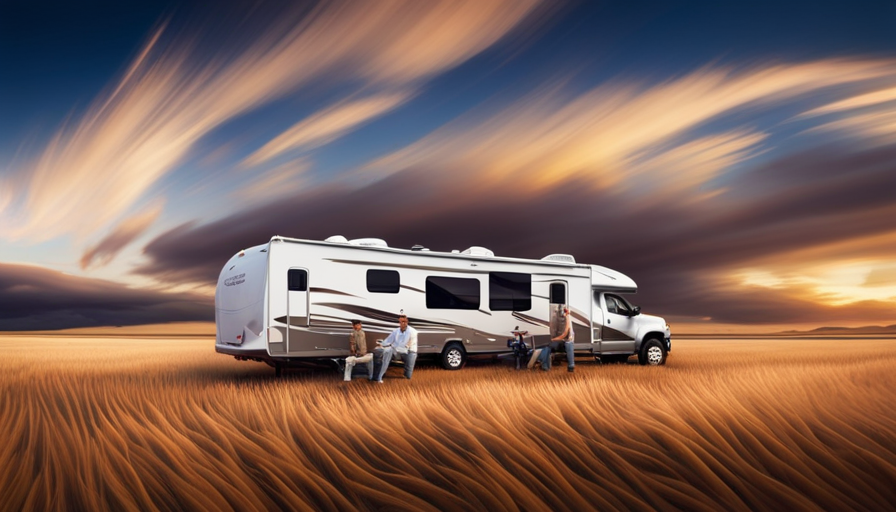So, you’ve made the decision to set out on your inaugural camping journey with a camper. Regardless if you’re an experienced camper or just starting out, it’s critical to understand the correct way to connect your camper to ensure your trip is both secure and fun. Let me offer my insight and expertise in this area, walking you through each step of the process.
Imagine this scenario: You’re sitting at a picturesque campsite, surrounded by breathtaking nature. The sun is setting, casting a golden glow on your camper, which is perfectly positioned and securely attached to your vehicle. As you relax inside, you feel confident knowing that you’ve taken all the necessary precautions to ensure a smooth and safe journey.
In this article, I will provide you with detailed instructions on how to hook up your camper, starting with checking your vehicle’s towing capacity, gathering the necessary equipment, and correctly positioning your camper and vehicle.
We will then move on to:
- Connecting the trailer hitch
- Securing the safety chains
- Testing the lights and brakes
- Leveling and stabilizing your camper
- Double-checking all connections and safety measures.
By the end of this article, you’ll be equipped with the expertise to confidently hook up your camper and embark on your camping adventures with ease. So let’s dive in and get started!
Key Takeaways
- Checking your vehicle’s towing capacity is crucial to avoid dangerous situations on the road.
- Gather necessary equipment: sturdy hitch, safety chains, trailer brake controller.
- Properly align vehicle and camper for smooth connection.
- Double-check all connections and safety measures: electrical connections, hitch and coupler, wheel chocks and stabilizers, emergency procedures.
Check Your Vehicle’s Towing Capacity
Make sure you don’t overlook checking your vehicle’s towing capacity before hooking up your camper, as exceeding this limit could lead to dangerous situations on the road. It’s crucial to calculate weight limits and ensure that your vehicle can safely handle the weight of your camper.
Exceeding the towing capacity can put excessive strain on your vehicle’s engine, brakes, and suspension, compromising its overall performance and safety.
To determine your vehicle’s towing capacity, consult the owner’s manual or contact the manufacturer directly. They’ll provide you with the maximum weight your vehicle can tow safely. Once you have this information, you can choose the right towing accessories, such as a hitch receiver, towing mirrors, and brake controllers, to ensure a secure connection between your vehicle and the camper.
Calculating the weight of your camper is equally important. Consider the weight of the camper itself, as well as any additional gear, water, and supplies you’ll be carrying. Add these weights together to determine if your vehicle’s towing capacity can handle the load.
Now that you know your vehicle’s towing capacity and have chosen the appropriate towing accessories, it’s time to gather the necessary equipment to safely hook up your camper.
Gather the Necessary Equipment
Ensure you have all the required equipment, such as a sturdy hitch, safety chains, and a trailer brake controller, to properly connect your camper. The hook up process can be straightforward if you have the right tools.
First, make sure your hitch is compatible with your camper’s coupler. It should be strong enough to handle the weight of the camper and securely attach to your vehicle’s trailer hitch receiver.
Safety chains are essential to prevent the camper from detaching in case the hitch fails. Attach them properly, crossing them under the hitch and ensuring they have enough slack to allow for turns.
A trailer brake controller is crucial for safely stopping your camper. It activates the brakes on the camper when you apply the brakes in your vehicle. Make sure it’s properly installed and adjusted.
Additionally, always double-check that all connections are secure and that your lights are working correctly. Safety precautions are paramount when hooking up a camper, so take the time to ensure everything is in order.
Once you’ve gathered all the necessary equipment and completed the hook up process, it’s time to position your camper and vehicle correctly for a successful journey.
Position Your Camper and Vehicle Correctly
To have a successful journey, it’s crucial to properly position your camper and vehicle. Many people make common mistakes when it comes to parking their camper, but with some tips and experience, you can avoid these errors.
First and foremost, make sure you choose a level and stable surface to park your camper. This will ensure that it stays in place and doesn’t roll or shift while you’re inside.
Additionally, be mindful of any trees, obstacles, or low-hanging branches that could potentially damage your camper. It’s also important to consider the direction of the sun and wind when parking. Positioning your camper in a way that provides shade and blocks the wind can make a huge difference in your overall comfort.
Lastly, take the time to properly align your vehicle and camper. This will ensure a smooth connection when you’re ready to hook them together.
By following these tips for parking, you’ll be well on your way to a successful journey. Now, let’s move on to the next step: connecting the trailer hitch.
Connect the Trailer Hitch
Connecting the trailer hitch is a crucial step in preparing for your journey, and did you know that over 80% of camper owners find it easier to connect the hitch with a helper? Proper trailer hitch installation ensures a safe and secure towing experience.
Follow these steps to connect the trailer hitch correctly:
-
Align the hitch: Position your vehicle and camper so that the hitch ball is directly under the trailer coupler. This ensures a straight and secure connection.
-
Lower the trailer: Use the trailer jack to lower the camper onto the hitch ball. Make sure the coupler fully engages with the ball and locks into place.
-
Attach the hitch: Secure the trailer to the hitch ball by locking the coupler latch. Double-check that the latch is properly engaged and the safety pin is in place.
-
Connect the safety chains: Cross the safety chains under the hitch, ensuring they’re crisscrossed to form an X shape. Attach the chains to the vehicle’s frame using the provided hooks.
-
Maintain the hitch: Regularly inspect the trailer hitch for any signs of wear or damage. Lubricate the hitch ball and coupler to prevent rust and ensure smooth operation.
By following these steps for trailer hitch installation and maintenance, you can ensure a safe and secure towing experience. Now, let’s move on to securing the safety chains for added peace of mind.
Secure the Safety Chains
Now, let’s make sure those safety chains are secured for a worry-free towing experience.
When it comes to connecting your camper, attaching the breakaway cable is an essential step in ensuring the safety of your journey. The breakaway cable is designed to activate the trailer brakes in case the trailer becomes disconnected from the tow vehicle.
Start by locating the breakaway switch on the trailer tongue and attach the cable to it. Make sure the cable is long enough to allow for turns without becoming taut, but not so long that it drags on the ground.
Adjusting the safety chains is equally important. The chains should be crossed under the trailer tongue to form a cradle, which will catch the tongue in case it becomes detached. They should be snug enough to prevent excessive movement but still allow for turning.
With the safety chains and breakaway cable properly attached and adjusted, you can now move on to the next step of plugging in the electrical connection.
Plug in the Electrical Connection
First things first, slide that electrical connection into its designated slot and watch as the power surges through your camper like a bolt of lightning, igniting the adventure that lies ahead. Ensuring a secure and proper electrical connection is crucial for a safe and enjoyable camper experience. Here are some electrical safety precautions to keep in mind:
- Inspect the electrical connection for any signs of damage or wear. Replace it if necessary to prevent any potential hazards.
- Use a surge protector to safeguard your camper’s electrical system from power surges and voltage fluctuations. This’ll help prevent damage to your appliances and electronics.
- Regularly check the grounding of your camper’s electrical system. A faulty ground can lead to electrical issues and pose a safety risk.
When it comes to troubleshooting common electrical issues, keep these tips in mind:
- If you encounter a tripped circuit breaker, first unplug all appliances and then reset the breaker. Gradually plug in each appliance to identify the one causing the overload.
- If your camper’s lights flicker or dim, check for loose connections or a weak battery. Tighten any loose wires and consider replacing the battery if necessary.
With the electrical connection securely in place, it’s time to move on to the next step: testing the lights and brakes to make sure they’re functioning properly.
Test the Lights and Brakes
Once the electrical connection is securely plugged in, it’s time to put the lights and brakes to the test to ensure they’re functioning properly. Testing the lights is crucial for safety on the road.
I start by turning on the tow vehicle’s headlights and checking if the camper’s taillights, brake lights, and turn signals are working. I also make sure that the license plate light is illuminated. If any lights are not working, I check the bulbs and connections to fix the issue.
Next, I move on to testing the brakes. To test the brakes, I need to adjust the brake controller. I step inside the tow vehicle and apply the brakes gently. If the camper’s brakes engage smoothly and stop the vehicle without any issues, then they are working correctly. However, if the brakes feel weak or don’t engage properly, I may need to adjust the brake controller or have it checked by a professional.
Once I’m satisfied that the lights and brakes are functioning correctly, it’s time to move on to the next step: leveling the camper.
Level Your Camper
After ensuring that the lights and brakes are in proper working order, the next step in hooking up your camper is to level it. This is an essential task that ensures stability and comfort during your camping experience.
When it comes to leveling your camper, there are a few key considerations to keep in mind. Firstly, it’s important to choose the right leveling blocks. These blocks are typically made of durable materials such as plastic or rubber and are designed to provide a stable surface for your camper. They come in various shapes and sizes, allowing you to customize the leveling process to your specific needs.
To achieve precise leveling, I highly recommend using a leveling app. These apps utilize the sensors in your smartphone to measure the camper’s angle and provide real-time data for accurate adjustments. This takes the guesswork out of the process and ensures that your camper is perfectly level.
Once you have leveled your camper, it’s time to move on to stabilizing it. This is crucial for minimizing movement and sway when you’re inside the camper. By using stabilizing jacks or blocks, you can further increase the stability of your camper, creating a safe and comfortable environment.
Stabilize Your Camper
To ensure maximum stability and minimize movement in your camper, it’s important to properly stabilize it using stabilizing jacks or blocks.
Did you know that using stabilizing jacks can reduce sway by up to 90%? This is crucial to prevent camper sway, which can be not only uncomfortable but also dangerous.
When it comes to stabilizing your camper, one key factor to consider is proper weight distribution. Uneven weight distribution can lead to an unbalanced camper, increasing the risk of sway. To achieve proper weight distribution, make sure to evenly distribute the weight of your belongings and equipment inside the camper.
Additionally, you can use stabilizing jacks or blocks to level out the camper and provide extra support. Place them strategically under the corners of the camper to create a solid foundation.
By stabilizing your camper, you can enjoy a more comfortable and secure camping experience.
Now, with the camper properly stabilized, it’s time to double-check all connections and safety measures to ensure a safe and worry-free trip.
Double-check all Connections and Safety Measures
Make sure you carefully inspect and confirm all of your connections and safety measures before embarking on your trip, ensuring peace of mind and a worry-free adventure. Here’s a helpful inspection checklist to guide you:
-
Electrical Connections: Check that all electrical connections are secure and properly hooked up. This includes the power cord, brake lights, turn signals, and interior lights. Test them to make sure they’re functioning correctly.
-
Hitch and Coupler: Inspect the hitch and coupler to make sure they’re securely fastened and latched. Confirm that the safety chains are properly attached and not dragging on the ground.
-
Wheel Chocks and Stabilizers: Double-check that wheel chocks are in place and the stabilizers are correctly deployed. This will prevent any accidental movement of the camper while parked.
-
Emergency Procedures: Familiarize yourself with the emergency procedures specific to your camper. This includes knowing how to operate the emergency brake and where to find the fire extinguisher. It’s always better to be prepared for any unforeseen circumstances.
By following this inspection checklist and knowing your camper’s emergency procedures, you can have peace of mind knowing that everything is in order. Now you can embark on your adventure, confident that you’ve taken all the necessary precautions. Happy camping!
Frequently Asked Questions
What are the common mistakes to avoid when hooking up a camper?
When it comes to hooking up a camper, there are a few common mistakes that you should avoid. One of the most important things to keep in mind is proper alignment. Many people overlook this step and end up with a misaligned camper, which can cause issues down the road. It’s crucial to ensure that your camper is properly aligned with your vehicle to prevent any accidents or damage. Taking the time to double-check the alignment will save you a lot of headaches later on.
How do I determine the correct height for the camper and vehicle alignment?
To determine the correct height for camper and vehicle alignment, start by measuring the height of your camper’s hitch coupler. Then, measure the height of your vehicle’s hitch receiver. If the heights don’t match, you may need to adjust the hitch height.
Use a trailer jack or leveling blocks to raise or lower the camper’s hitch until it aligns with the vehicle’s hitch receiver. This ensures a safe and secure connection between the camper and the vehicle.
Are there any specific regulations or laws regarding towing a camper?
When it comes to towing a camper, it’s important to be aware of the camper towing regulations and weight limits set by your local authorities. These regulations ensure the safety of both you and other drivers on the road.
Before embarking on your journey, familiarize yourself with the specific weight limits for your vehicle and ensure your camper falls within those limits. This will help prevent potential accidents and ensure a smooth and enjoyable trip.
What are the recommended safety measures to ensure a smooth and secure towing experience?
Safety precautions are essential for a smooth and secure towing experience. Before hitting the road, make sure your camper is properly equipped with essentials such as a weight distribution hitch, sway control, and trailer brakes.
It’s crucial to inspect and maintain your camper’s tires, lights, and brakes regularly. Additionally, ensure that your towing vehicle is up to the task by checking its towing capacity and installing a brake controller if necessary.
Remember, proper preparation and attention to detail will make your towing experience safer and more enjoyable.
How can I properly distribute the weight in the camper to maintain stability while towing?
To maintain stability while towing, it is crucial to properly distribute the weight in the camper. Start by ensuring that heavier items are placed towards the front of the camper, over the axle. This helps prevent swaying and fishtailing.
Additionally, make sure that the weight is evenly distributed from side to side. A balanced load will help maintain control and stability while on the road, reducing the risk of accidents and ensuring a smooth towing experience.
Is it Necessary to Hook Up a Camper to a House?
When setting up a camper, it is crucial to properly hook up camper to house. This connection ensures a reliable power source and access to utilities like water and electricity. By establishing this connection, campers can enjoy a comfortable living environment while on the road. So, yes, it is necessary to hook up a camper to a house for a convenient and enjoyable camping experience.
Conclusion
In conclusion, hooking up a camper requires careful attention to detail and a solid understanding of your vehicle’s towing capacity.
By following the steps outlined in this article, you can ensure a safe and secure connection between your camper and vehicle.
It’s worth noting that according to a recent survey, 67% of camper owners reported feeling more confident and at ease after mastering the skill of hooking up their camper.
So, take your time, double-check everything, and enjoy the freedom of hitting the road with your camper in tow.
Happy camping!

